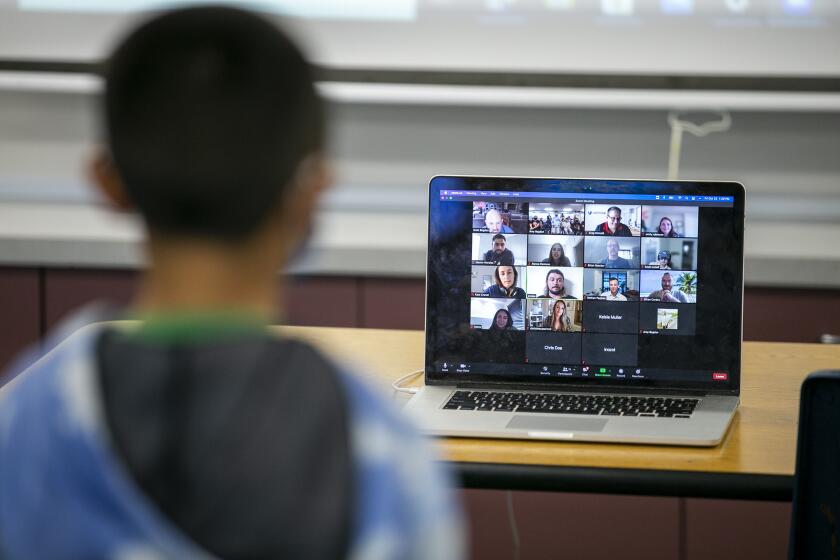Column: Maybe you shouldn’t read this column on your phone
We humans are a puzzle.
We are capable of dazzling brilliance. We’ve sent rockets into space, cured terrible diseases, built complex, sophisticated civilizations and created awe-inspiring works of art.
But put a cell phone in our hands and we devolve into heedless idiots, unaware of the world around us. We become like a dog that’s so obsessed with chasing a squirrel that it runs into the path of an oncoming car; as preoccupied as a cat with a ball of yarn, as oblivious as a slug about to be squashed underfoot.
The negative implications of our distraction by mobile technology at home and school have been all too apparent for some time. That’s why many teachers collect cell phones at the start of each class and some parents ban the devices at the dinner table.
But the issue goes beyond the detrimental effects on face-to-face social interactions and classroom attentiveness, to the point where we’ve become a danger to ourselves and others.
We’ve become so distracted by our mobile devices that many safety advocates and policymakers, among others, believe we can no longer be trusted to pay attention when our lives depend on it, when we’re driving, cycling, or — the most recent focus of concern — walking across the street.
How bad is the problem?
Consider some recently released statistics, which showed that pedestrian deaths surged more than 80% in the city of Los Angeles over a two-year period ending in 2017. That finding comported with national trends; data show that pedestrian deaths are up across the country.
While other factors, such as speeding, are surely to blame, officials also believe that distraction — by drivers and pedestrians alike — is a significant factor behind the increase.
Many safety professionals also believe that cell phone distraction is leading to an increase in non-traffic related injuries that can result from mishaps such as falling off of curbs and crashing into stationary objects or other people.
It’s a pervasive issue. The American Academy of Orthopedic Surgeons reports that 40% of Americans say they’ve witnessed a distracted-walking incident, while a quarter say they’ve been involved in such an incident themselves. That’s a lot of incidents.
Several years ago we began tackling the problem of distracted driving and some headway has been made. Fifteen states, including California, ban handheld cell phone use while driving. Many governmental agencies and nonprofits have also engaged in extensive public relations campaigns to warn against even the hands-free use of cell phones by drivers, arguing that any distraction is too dangerous.
Now some municipalities are looking at remedies for distracted walking.
The small city of Montclair in Los Angeles County, for instance, recently attracted nationwide attention with its decision to ban distracted walking while crossing intersections. This year it began issuing fines of up to $100 to pedestrians talking on their phones, texting or listening to music with headphones or earbuds while crossing the street.
Such responses, while considered overly drastic by some observers, are nonetheless almost certain to be adopted in more areas.
They will be fighting against strong, innate urges, for while the technology that’s distracting us is relatively young, the impulses they reveal are ancient and deeply embedded in our human DNA.
People are inherently social animals, explained Dr. Pamela Rutledge, director of the Media Psychology Research Center in Newport Beach.
“Phones are portals to a social world — voice, text, email, social media,” she said. Our “need to know tendency” means that mobile technology also feeds the human survival instinct. Distracting as they are, cell phones are deeply compelling to us in the most fundamental sense.
The danger arises because, despite what many people believe, we are incapable of focusing on more than one thing at a time.
“Humans can’t multitask,” Rutledge said. “Some people are very good at task-switching, but what you don’t pay attention to you might not see, not even with your peripheral vision. It’s called inattention blindness.”
So what’s the solution?
The answer is simple, really. People should not be looking at their phones while they are in motion, whether they are walking, driving, salsa dancing or juggling chainsaws.
Or as Rutledge more articulately states, “The solution is to recognize our cognitive limitations and self-regulate. Decide what’s most important to you — safety, being on time, checking Facebook or making the call.
“It’s really about choice,” she said. “Taking your eyes off the road for a second (even to fish something non-technology related off the floor) is all it takes to miss traffic cues.”
Getting people to comply with such common-sense advice is the hard part. It all goes back to those competing instincts — our compelling need to check in with a bigger world versus the imperative of being aware of our immediate surroundings.
Those instincts will continue to battle with each other, although right now, our cell phones seem to be winning. Whether we find the will to ignore our phones in the interest of avoiding bodily harm remains very much an open question.
PATRICE APODACA is a former Newport-Mesa public school parent and former Los Angeles Times staff writer. She lives in Newport Beach.
All the latest on Orange County from Orange County.
Get our free TimesOC newsletter.
You may occasionally receive promotional content from the Daily Pilot.




